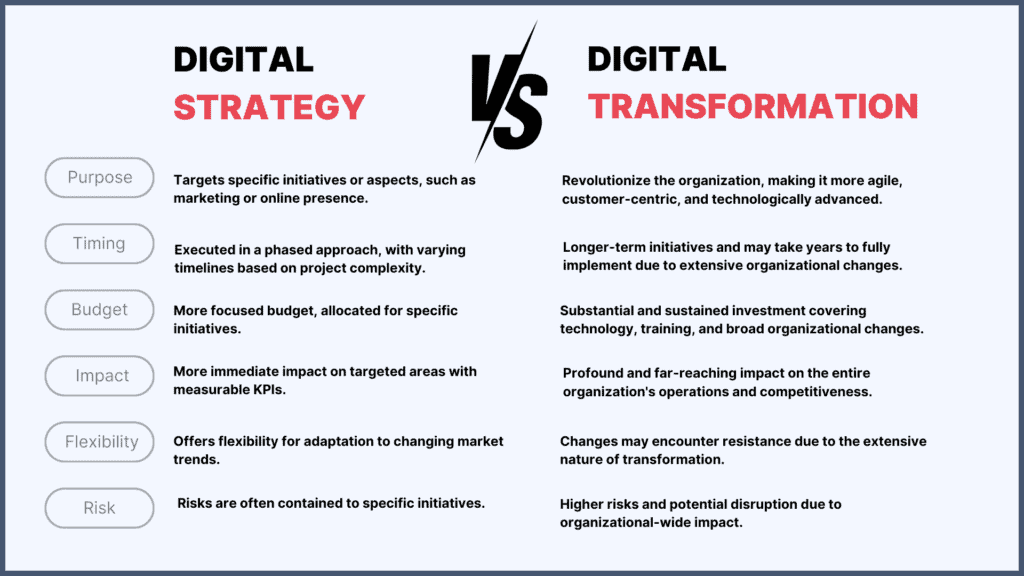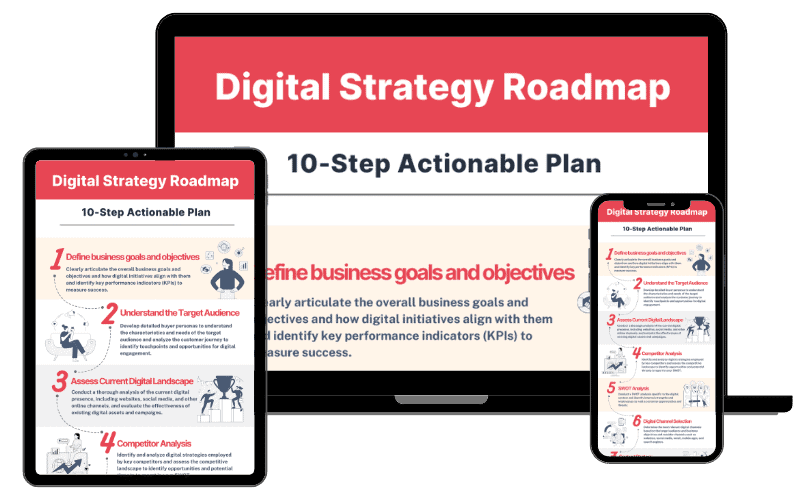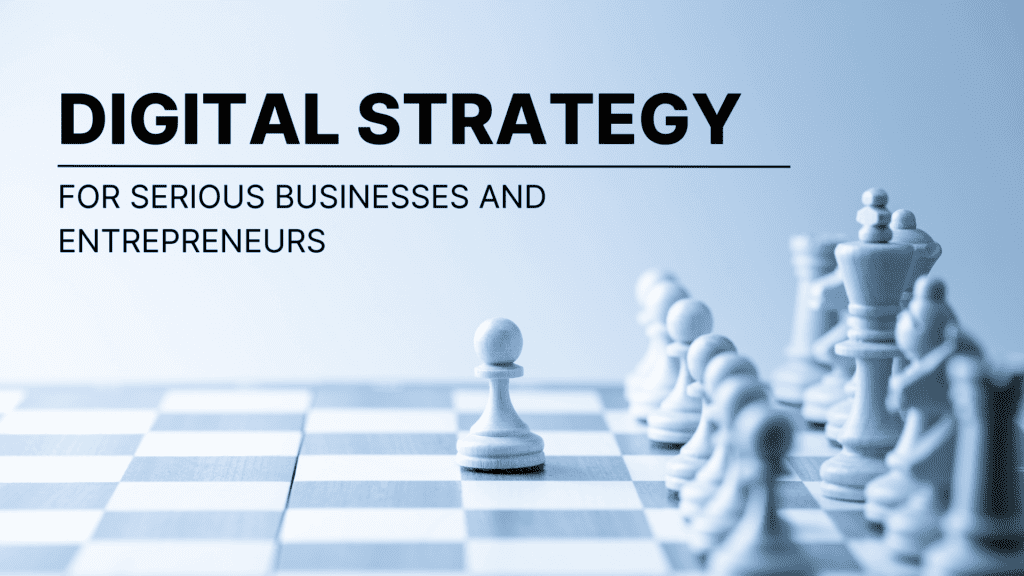In today’s dynamic business landscape, mastering digital strategy is essential for sustained success. In this guide, we are covering everything you need to know to create a robust digital strategy framework and actionable roadmap to unlock the full potential of digital strategies.
We will cover key aspects from understanding your audience and conducting a SWOT analysis to implementing a robust technology infrastructure. Whether you’re a digital novice or a seasoned professional, we will walk through every step and provide additional resources to ensure you leave this page with a solid understanding of how to build your digital strategy and set your project, business, and team for success!
Ready! Let’s start with the fundamental concept of digital strategy.
What is digital strategy?
A digital strategy is a comprehensive plan that outlines how an organization will leverage digital technologies, channels, and assets to achieve its goals and objectives. It encompasses the use of various digital tools, platforms, and tactics to enhance the overall performance and effectiveness of the organization in the digital landscape.
The Good Strategy
A well-developed digital strategy aligns with the overall business strategy and takes into account the evolving nature of technology and consumer behavior. It aims to capitalize on digital opportunities, address challenges, and stay competitive in a rapidly changing digital environment.
The goals of a digital strategy may include improving customer engagement, increasing brand visibility, driving sales, optimizing operational efficiency, and staying ahead of industry trends. Digital Leaders should start planning these strategic initiatives to stay relevant in their competitive environment and to thrive in the digital age.
Digital strategy vs. digital transformation

Digital strategy emphasizes utilizing digital tools, technologies, and channels to improve customer experiences as well as the efficacy of business processes. It usually makes a short-term impact on the company.
On the contrary, an organization’s approach toward a complete digital transformation into something that supports digital operations requires fundamental organizational shifts and changes to its culture, workings, and model. This transformation has a long-term impact on the company.
For example, a retail company aims to improve its online sales;
- The digital strategy includes developing a targeted e-commerce optimization plan, enhancing the online shopping experience, and implementing digital marketing strategies for specific products.
- Digital transformation includes overhauling the entire business model, integrating an omnichannel approach, implementing new technologies like RFID for inventory management, and fostering a company-wide cultural shift toward a customer-centric mindset.
Advantages of digital strategy
A well-executed digital strategy offers businesses a range of advantages, including increased reach, cost-effectiveness, data-driven decision-making, and the ability to adapt to a dynamic digital landscape. It plays a crucial role in staying competitive and meeting the evolving expectations of the modern consumer. Benefits and advantages include:
- Global reach and expanded online presence for audience growth.
- Personalization and targeting enhance digital experiences.
- Cost-efficiency compared to traditional marketing methods.
- Data-driven decisions optimize strategies.
- Customer engagement through social media and interactive content.
- Flexibility to adapt quickly to market changes.
- Digital technologies contribute to a seamless customer experience.
- Strategic planning provides a competitive edge.
- Early adoption of technologies sets a company apart.
- Clear metrics and analytics offer insights into campaign success.
- Key performance indicators (KPIs) ensure measurable ROI.
- Digital strategies support agile marketing for rapid adjustments.
- Quick responses to market trends contribute to overall effectiveness.
Examples of digital strategies
A good way to identify a company’s digital strategy is to look at how it can capitalize on new opportunities in the digital landscape while staying competitive in the age of rapid technological advancement. Here are examples from popular brands and business models;
- Amazon’s digital strategy to boost sales with personalized recommendations. With the Implementation of features like “customers who bought this also bought” to increase engagement. This resulted in enhanced satisfaction and increased sales through tailored shopping.
- Coffee company Starbucks’ digital strategy to drive loyalty with a mobile app and rewards program. Digital loyalty programs through mobile apps streamline orders and offer personalized promotions, which resulted in improved convenience, higher app adoption, increased brand loyalty, and drove mobile sales.
- Electrical engineer Tesla’s strategy to improve vehicles remotely through over-the-air updates. These updates enhanced features without requiring physical service visits and quickly resulted in enhanced client satisfaction, ongoing improvement, and a competitive edge.
- Multinational Athletic Footwear Nike emphasizes digital and direct-to-consumer (DTC) to build market strength. With a more solid digital ecosystem that offers personalized experiences and exclusive content, Nike adapted to trends, captured direct revenue, and built a strong brand connection with a new digital audience.
- Car manufacturer Renault set its digital strategy to boost brand visibility and customer engagement through a multifaceted approach, enhancing its online presence with a user-friendly website, optimizing social media channels, and implementing SEO strategies. Renault launched a mobile app with virtual showroom features and integrated e-commerce capabilities for online car purchases.
There are many other examples of companies that adapted to the new digital economy and included digital technology, digital initiatives, and digital services to build a robust digital strategy.
But where to start? What is the structure? How to manage priority initiatives? Ho to build competitive advantages? How to select new technology? How to invest in the right digital talent? How to make a strategic impact? What are the digital processes and emerging technologies to create your robust digital strategy? For that, you need to have a digital strategy framework, your ‘North Star’ to execute successful plans.
Let’s dive in!
How to design a digital strategy framework
A digital strategy framework provides a structured and systematic approach for organizations and businesses to develop, implement, manage, and execute a digital strategy, ensuring alignment with business goals, a deep understanding of the target audience, and the flexibility to adapt to changing digital landscapes.
The Good Strategy
FREE 10-Step Digital Strategy Roadmap
Everything you need to structure your digital strategy framework and launch successful digital strategies.
We respect your privacy. Unsubscribe at anytime.

If you are launching new digital initiatives for your project, your business, or your client, you should follow these 10 steps to create a robust digital strategy;
Step 1:Define business goals and objectives
Business goals set the strategic direction and purpose of an organization, providing a high-level vision.
Business objectives, on the other hand, break down these goals into specific, measurable targets, serving as the actionable steps that guide the company toward the realization of its broader aspirations.
Together, goals and objectives create a framework for your digital strategy and decision-making within a business. While the terms are often used interchangeably, they serve distinct purposes:
- Business goals are broad, overarching statements that articulate the overall direction and purpose of the organization. They represent the desired, high-level achievements that contribute to the company’s long-term success. Goals are often qualitative, inspirational, and timeless. They provide a sense of purpose and vision for the entire organization.
Example: “Become a leader in sustainable technology solutions,” or “Achieve global market expansion.”
- Business objectives are specific, measurable, achievable, relevant, and time-bound (SMART) targets that support the attainment of business goals. They provide a more detailed and concrete roadmap for reaching the broader aspirations outlined in the goals. Objectives are quantitative, precise, and time-sensitive. They serve as actionable steps toward realizing the overarching goals.
Example: “Increase market share by 15% within the next fiscal year,” or “Reduce production costs by 20% over the next two years.”
Further reading:
- How to track and set business objectives?
- SMART Goals – How to make them achievable?
- Setting Objectives
Step 2: Understand your target audience
Understanding the target audience is a pivotal concept that involves gaining profound insights into the characteristics, behaviors, and preferences of the specific group of individuals a business aims to reach through online channels.
It goes beyond demographic information and delves into psychographic details, such as lifestyle, interests, and values.
A comprehensive understanding of the target audience enables businesses to tailor their digital strategies, content, and marketing initiatives in a way that resonates with and engages their audience effectively.
This knowledge allows for the creation of personalized and relevant experiences, ultimately fostering stronger connections between the brand and its online audience. By deciphering the digital habits and expectations of the target audience, businesses can optimize their online presence, enhance user experiences, and drive more impactful and targeted digital campaigns.
Further Reading:
Step 3: Assess the current digital landscape
The third step in building a robust digital strategy by assessing your environment. This assessment is a crucial process for businesses seeking to navigate and thrive in the complex and dynamic online environment.
Conducting this analysis involves a comprehensive review of the current state of the digital landscape, including platforms, trends, competitors, and technological advancements.
This assessment will help formalize steps 4 and 5 of our framework, which are competitor and SWOT analyses.
To initiate this assessment, you should start by identifying and evaluating the various digital channels relevant to your industry, such as social media, search engines, and emerging technologies. Analyzing competitor activities and industry benchmarks provides valuable insights into best practices and areas for differentiation. Monitoring customer behaviors and preferences in the digital space through data analytics is essential for understanding audience dynamics.
Additionally, staying abreast of technological advancements and digital capabilities to ensure that businesses are prepared to leverage new tools and platforms. Regular audits of digital assets, such as websites and apps, help assess their effectiveness and user-friendliness.
The combination of these elements allows you to adapt and optimize your digital strategies in response to the ever-evolving digital landscape, ensuring relevance, competitiveness, and sustained growth.
Step 4: Competitor analysis
Competitor analysis is a strategic step that involves systematically evaluating and understanding the strengths and weaknesses of competitors in the same industry. This process enables organizations to gain valuable insights into their competitors’ strategies, market positioning, and overall performance.
Businesses typically conduct competitor analyses to identify opportunities for differentiation, uncover potential threats, and refine their strategic initiatives. The assessment often includes an examination of competitors’ product or service offerings, pricing strategies, marketing approaches, and customer satisfaction levels.
By understanding the competitive landscape, companies can make informed decisions about their positioning, marketing campaigns, and areas for improvement. Competitor analysis is a dynamic and ongoing process, essential for adapting to market changes and maintaining a competitive edge in the ever-evolving business environment.
Further Reading:
Step 5: SWOT analysis
Whether you use it for new business models or to help reposition your existing business, a SWOT analysis is a strategic planning tool used to assess and evaluate the internal Strengths and Weaknesses of an organization, as well as the external Opportunities and Threats it faces in its operating environment, thus the acronym SWOT.
- Strengths: Internal factors that give an organization a competitive advantage or unique capabilities. These could include a strong brand reputation, a skilled workforce, or efficient internal processes.
- Weaknesses: Internal factors that place the organization at a disadvantage compared to others. This may involve areas such as limited resources, outdated technology, or internal inefficiencies.
- Opportunities: External factors in the environment that the organization could exploit to its advantage. Opportunities might arise from market trends, technological advancements, or changes in regulations that the organization can leverage.
- Threats: External factors that could negatively impact the organization. These may include competition, economic downturns, changing consumer preferences, or other external challenges.
Further Reading:
Step 6: Digital channel selection
After you run your SWOT analysis, step 6 is to select the right digital channel mix. Selecting digital channels refers to the strategic process of choosing and utilizing various online platforms and communication channels to reach and engage with a target audience effectively.
In the context of digital marketing and communication, businesses and organizations have a plethora of channels at their disposal, including social media platforms, search engines, email marketing, websites, blogs, online advertising, affiliate and partnership marketing, and more.
Digital channel selection involves assessing the strengths and weaknesses of each channel in relation to the organization’s goals, target audience, and overall marketing strategy. It requires a thoughtful consideration of factors such as user demographics, engagement patterns, and the nature of content that resonates on each platform.
The goal is to identify the most suitable digital channels that align with the organization’s objectives, allowing for a strategic and efficient allocation of resources to maximize reach, engagement, and impact in the digital landscape.
Further reading:
- How to Identify the Right Digital Marketing Channels for Your Business
- 12 Digital Marketing Channels (That Work in 2023)
- What is a Media Mix & The Most Effective Types [HubSpot Blog Data]
Step 7: Content strategy
Content is King. That was true yesterday, that is true today and will be tomorrow.
In your digital strategy framework, content strategy involves the planning, development, and management of content to meet specific business goals and engage your target audience effectively.
It is a comprehensive approach that goes beyond the creation of individual pieces of content, focusing on the larger context of how content contributes to the overall success of an organization. A well-defined content strategy takes into account the organization’s objectives, target audience, and the various channels through which content will be distributed.
It includes the creation of a content calendar, outlining the timing and frequency of content publication, as well as considerations for content formats, tone, and style. Content strategy also involves content optimization for search engines (SEO), ensuring that content is discoverable by the target audience. It aims to create a consistent and cohesive brand voice across different platforms and touchpoints.
Regular analysis and refinement of the strategy based on performance metrics contribute to its ongoing effectiveness. Ultimately, a robust content strategy plays a key role in building brand authority, fostering audience engagement, and driving desired actions, such as conversions or brand loyalty.
Further reading:
- Content strategy basics
- Developing a content strategy
- The ultimate guide to content marketing strategy
Step 8: Technology Infrastructure
When companies reach digital maturity, it is usually due to how they invest in technology and place big bets on infrastructures set to foster growth. Technology infrastructure is a critical component within a digital strategy framework, providing the foundational backbone that enables the execution of digital initiatives and supports overall business objectives.
It encompasses the hardware, software, networks, data management,, and other technological components that organizations rely on to operate in the digital landscape and to manage transformation actively.
In a digital strategy context, a robust technology infrastructure is essential for seamless integration, data management, and the delivery of digital products and services.
Further reading:
Step 9: Budgeting and resource allocation
We cannot design an effective digital strategy framework without including budget and resource allocation.
Budgeting and resource allocation are integral components of a digital strategy framework, playing a crucial role in the successful execution of digital initiatives.
Effective budgeting and resource allocation within a digital strategy framework requires a balance between short-term needs and long-term goals.
In the context of digital strategy, organizations need to allocate financial resources and human capital strategically to support all the various digital activities and objectives outlined in steps 1 to 8.
Here are key considerations:
- Strategic prioritization by allocating resources based on the strategic priorities identified, ensuring that financial and human resources are directed towards initiatives that align with overall business objectives.
- Technology investments: Digital strategies often involve leveraging new technology, and software platforms, or upgrading existing ones. Budgeting allows you to allocate funds for technology investments, ensuring that the necessary tools and platforms are in place to support digital operations effectively.
- Talent and skills development remains one of the largest investments so you need to be prepared to budget for training and skill development ensuring that your workforce possesses the expertise needed to implement and manage digital initiatives.
- Allocating budget resources for content creation, digital marketing campaigns, and social media activities is essential to reach and connect with the target audience effectively.
- To assess the performance of digital strategies, organizations need to allocate resources for data analytics tools and measurement systems. This allows for the collection and analysis of relevant data to make informed decisions and optimize strategies over time.
- As digital operations expand, allocating resources for cybersecurity measures is critical. Safeguarding digital assets, and customer information, and maintaining the integrity of digital platforms are essential considerations in budget planning.
- Budgeting for iterative testing and optimization activities ensures that organizations can refine and improve digital strategies based on performance data and user feedback.
- Budgeting for scalability allows organizations to adapt their resources as needed to meet evolving demands.
- Regular reviews and adjustments to the budget are necessary to align resources with changing priorities, technology advancements, and the dynamic nature of the digital environment.
Further reading:
- 6 Steps for Allocating Your Digital Marketing Budget Wisely
- The Best Free Business Budget Templates
- Resource Allocation: Optimizing Efficiency and Productivity
Step 10: Implementation Plan
In the final step of a digital strategy framework, the implementation plan comes to fruition through the execution of the strategies and initiatives outlined in the planning phase.
This phase involves putting the digital strategy into action, deploying resources, and actively managing and monitoring progress. In the next section, we will review how the digital framework is translated into an effective digital strategy roadmap.
But first, let’s review the key elements of the implementation plan that should include:
- Execution of the specific tactics and activities outlined in the digital strategy.
- Adhere to a set timeline. Effective project management ensures that tasks are completed within specified timeframes, contributing to the overall success of digital initiatives.
- Allocate budgetary and human resources as planned in previous steps
- Foster open communication and coordination among team members involved in the implementation.
- Implement testing protocols to evaluate the effectiveness of digital strategies.
- Collect data, analyze performance metrics, and use insights to make informed decisions.
- Gather feedback from stakeholders, users, and relevant metrics. A feedback loop ensures that the implementation plan remains adaptable and responsive to changing circumstances.
- If new technologies or skills are introduced as part of the digital strategy, ensure that the team receives the necessary training and development to maximize the use of these resources.
- Implement tools for real-time monitoring and analytics to track the performance of digital initiatives and regularly analyze data to make informed decisions and optimize strategies.
- Regularly review key performance indicators (KPIs) and other relevant metrics to measure the impact and effectiveness of the implemented strategies.
- Maintain thorough documentation throughout the implementation phase. Documenting processes, SOPs, outcomes, and lessons learned contributes to knowledge management, builds internal efficiencies, and facilitates future strategy refinement.
Remember to stay adaptable to unforeseen challenges and opportunities. The digital landscape is dynamic, and the ability to adapt the implementation plan in response to changing circumstances is crucial for long-term success.
That’s it! You’ve just designed your digital strategy framework!
Because this framework always evolves, embrace an iterative approach, by continuously reviewing and improving your digital strategies based on performance data and market changes, and stay agile and adaptable to evolving trends and technologies.
FREE 10-Step Digital Strategy Roadmap
Everything you need to structure your digital strategy framework and launch successful digital strategies.
We respect your privacy. Unsubscribe at anytime.

Creating your digital strategy roadmap
Once you put together the digital strategy framework, the next step involves translating the framework into a practical, step-by-step plan.
Here’s a guide on how to put together your digital strategy roadmap:
- Start by clearly articulating the specific objectives you aim to achieve with your digital strategy. These objectives should align with the overall business goals.
- Evaluate and prioritize the digital initiatives identified in your strategy framework. Consider factors such as impact, feasibility, and resource requirements.
- Establish realistic timelines and milestones for each initiative. Break down larger projects into manageable phases and set deadlines for achieving key milestones.
- Identify and allocate the resources required for each initiative, including budget, personnel, and technology. Ensure that resources are allocated appropriately to support the roadmap.
- If your digital strategy involves technology upgrades or implementation, outline a plan for acquiring, implementing, and integrating the necessary tools. Consider phased implementations to manage risks.
- Develop a content calendar that aligns with your content strategy. Clearly outline the types of content, frequency of publication, and distribution channels for each piece.
- Plan how you will market and promote your digital initiatives. This may involve digital advertising, social media campaigns, email marketing, or other channels.
- Identify any skill gaps within your team that need to be addressed to execute the digital strategy successfully. Develop a training plan to enhance the necessary skills.
- Anticipate potential challenges and risks associated with the digital initiatives.
- Develop contingency plans and risk mitigation strategies to address unforeseen issues.
- Establish a system for monitoring the progress of each initiative. Define key performance indicators (KPIs) and set up regular evaluations to assess the impact of the digital strategy.
- Implement feedback mechanisms to gather insights from customers, stakeholders, and internal teams. Use this feedback to make necessary adjustments to the roadmap.
- Develop a communication plan to keep stakeholders informed about the progress of the digital strategy. Regularly communicate milestones, successes, and any changes to the plan.
- Embrace an iterative approach, allowing for adjustments based on evolving market conditions, technological advancements, and feedback.
Best digital strategies to plan for 2025
The best digital strategies for 2025 depend on your industry, target audience, and business goals. Stay agile, monitor industry trends, and be ready to adapt your strategies based on the evolving digital landscape.
Here is a recap of the best digital strategies to consider for the year 2025;
- Integrate marketing efforts across multiple channels for a cohesive brand experience. This is critical to ensuring consistency in messaging and branding across digital platforms.
- Invest – or continue to invest – in artificial intelligence (AI) and automation to enhance efficiency using AI-driven personalization to supercharge your customer experiences, and automated workflows to build internal team efficiencies.
- Focus on Social and Shoppable Content on platforms like Instagram, Snapchat, and TikTok to create engaging content that captures audience attention in our fast-paced digital environment.
- Prioritize video content across platforms, including live streaming and interactive videos, and incorporate immersive technologies like augmented reality (AR) or virtual reality (VR) for unique video experiences.
- Optimize for Voice Search by Adjusting SEO strategies to accommodate the growing prevalence of voice search.
- Focus on affiliate and influencer strategies to take advantage of the boom of the creator economy.
- Strengthen community-building efforts through online forums, social groups, and user-generated content.
- Prioritize customer data privacy and security and adjust your plan to focus on first-party data tracking.
Best Digital Strategy Tools
- For SEO and keyword research
- For email marketing
- For social media management
- For project management
- For graphic design
- For AI chatbots
- For CRM and lead management
- For marketing automation
- For marketing attribution
- For content marketing
- For reporting
- For digital ads and media buying
- For competitive analysis
Wrap Up
If you are ready to take your business to the next step, you need to have a good plan for it.
Without a clear digital strategy, you are not setting up your business for success.
In this guide, we went through the concept of digital strategy and digital transformation, and how to craft effective digital strategies to maintain relevance in the ever-evolving digital landscape.
We discussed the importance of creating a strategic framework, by highlighting our 10 key components such as understanding the target audience, conducting a thorough SWOT analysis, and leveraging a robust technology infrastructure.
Finally, we provided you with the digital strategy roadmap for success that includes strategic prioritization, resource allocation, and a focus on technology investments, talent development, and customer engagement.
Needless to remind you of the importance of adaptability, testing, and continuous optimization in the implementation phase.
By integrating these elements into your digital strategy, you will be on your way to building a competitive edge and guaranteeing sustained relevance and success in a rapidly changing environment.
Your Success Starts with The Good Strategy!












